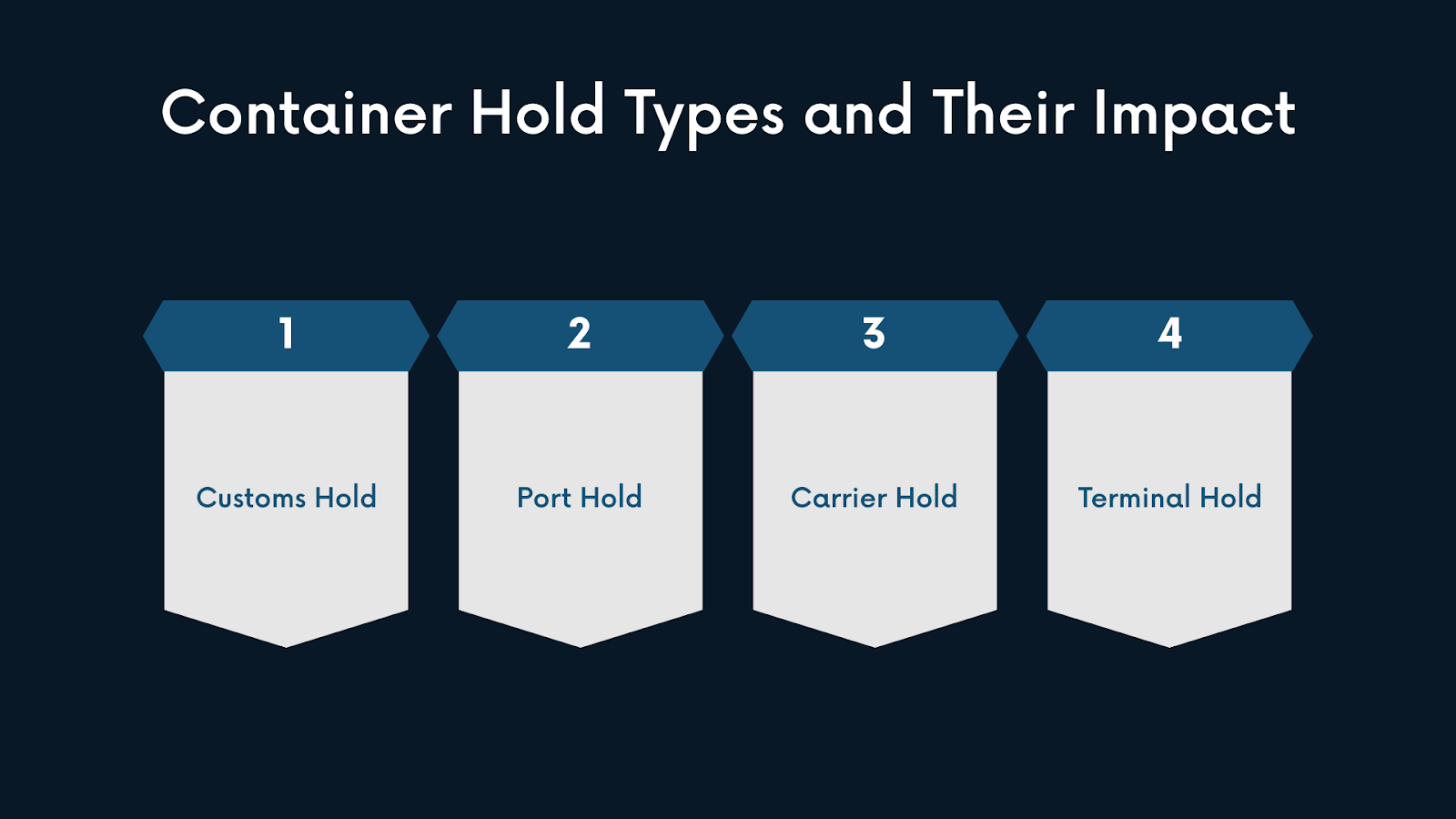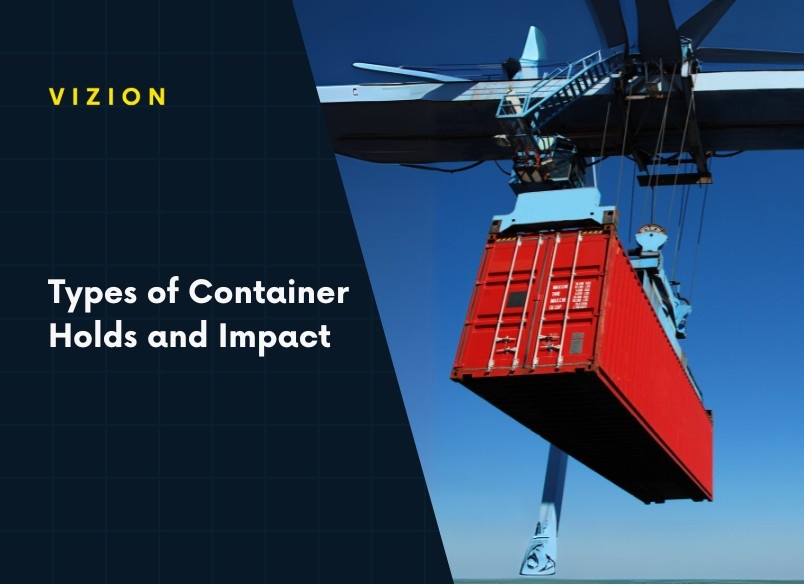Ever had a container delayed for days without a clear reason, just vague updates, rising fees, and silence from the port? If you’ve been there, you know the real cost of a container hold isn’t just time. It’s missed delivery windows, penalties, and strained customer relationships.
Here’s the reality: over 50% of shippers still have zero visibility into their ocean freight, and more than 20% rely on manual tracking that often tells them too little, too late.
In a world where cargo delays can ripple across entire supply chains, knowing when and why your container is on hold isn’t a nice-to-have. It’s mission-critical.
With real-time visibility powered by direct data from terminals, carriers, and ports, a renowned real-time container tracking solution like Vizion gives you a clear view of what’s happening and what to do next. So you’re never caught off guard again.
What Is a Container Hold?
A container hold is a formal pause in a shipment’s movement, typically enforced by customs, port authorities, carriers, or terminal operators. It prevents the container from advancing in the supply chain, whether that’s unloading, clearing customs, or being released for pickup.
Holds are triggered by a range of factors, including:
- Incomplete or inaccurate documentation
- Outstanding freight or port charges
- Regulatory or customs inspections
- Administrative backlogs or scheduling issues
While these checks are often necessary for compliance, security, and operational control, they can significantly disrupt timelines. A single hold can delay a shipment by several days, increasing demurrage or detention costs and impacting delivery commitments.
Why Container Holds Matter?
Container holds play a critical role in safeguarding the integrity of global trade. They are not just administrative pauses, they serve as necessary checkpoints to ensure regulatory compliance, cargo safety, and operational accuracy.
By enforcing holds, authorities can:
- Prevent misdeclared or improperly documented goods from entering the supply chain
- Mitigate security risks and enforce trade regulations
- Flag potential issues before cargo reaches its final destination
While disruptive, holds exist to maintain order in a highly complex, interconnected logistics environment. They help prevent fraud, reduce the risk of non-compliance, and ensure accountability across all involved parties.
Also read: Key Components when Tracking Vessels
Common Types of Container Holds and Their Impact

Not all holds are created equal. Different types of holds interrupt shipments in different ways. Here are the most common types and how they affect container flow:
1. Customs Hold
- Trigger: Incomplete or suspicious documentation, regulatory inspections, or random checks.
- Impact: Delays ranging from hours to days, potential demurrage charges, and disrupted delivery schedules.
- Vizion's Solution: Through the Customs Clearance API, Vizion offers real-time access to critical customs data, automating alerts for holds and releases. This proactive approach allows teams to address issues promptly, minimizing delays and associated costs.
2. Port Hold
- Trigger: Port congestion, administrative backlogs, or operational inefficiencies.
- Impact: Extended dwell times, increased storage fees, and strained carrier relationships.
- Vizion's Solution: Vizion's Port Performance Monitoring provides real-time insights into dwell times and terminal activity. By surfacing key milestones such as discharge and container availability, and improving ETA accuracy, Vizion enables logistics teams to anticipate delays and adjust plans proactively.
3. Carrier Hold
- Trigger: Unpaid freight charges, missing documentation, or contractual disputes.
- Impact: Containers withheld from release, leading to delivery delays and potential financial penalties.
- Vizion's Solution: By consolidating data from various carriers, Vizion offers a unified view of shipment statuses, highlighting any holds imposed by carriers. This transparency facilitates quicker issue resolution and ensures smoother cargo movement.
4. Terminal Hold
- Trigger: Scheduling conflicts, incomplete paperwork, or operational constraints at the terminal.
- Impact: Delays in container pickup, increased detention charges, and disrupted supply chain timelines.
- Vizion's Solution: With direct connections to over 60 ports and terminals worldwide, Vizion provides real-time updates on terminal events, including holds and releases.
Business Impact of Holds Without Real-Time Visibility
When a container goes on hold and no one knows until it's too late, the fallout can be expensive. Delays pile up. Costs climb. And customer trust takes a hit. Here's what happens when visibility is missing:
Late awareness of a container hold often means accumulating demurrage and detention fees, along with missed transit windows. These costs aren't just inconvenient; they erode profit margins and disrupt cash flow.
For example, if your team schedules drayage without realizing the container is still under a customs hold, you’ll incur trucking costs on top of terminal charges, all while the container sits untouched.
- Strained Customer Relationships
Unanticipated delays are more than just logistics issues; they're customer experience problems. Missed delivery promises create downstream disruptions for clients, putting pressure on service-level agreements and long-term trust.
For example, if your shipment to a key retail partner is held at the port and the update only arrives after the delivery deadline, you risk chargebacks or lost shelf space, both damaging and preventable.
- Inefficient Resource Allocation
Without real-time status updates, teams may deploy resources based on outdated or incomplete information.
For example, if a container flagged for inspection is still shown as “available” in your internal system, operations may schedule labor and dock space unnecessarily, leading to idle time and higher overhead.
How Vizion Transforms Container Hold Management?
Vizion gives shippers and logistics teams the visibility and control they need to manage container holds efficiently, with actionable data that drives real results:
- One source of truth for all container events: Get real-time updates on holds, releases, and milestones across carriers, terminals, and ports.
- Instant alerts for faster action: Receive automated notifications the moment a hold is placed, so teams can act early.
- Plug-and-play API integration: Sync container status directly into your TMS, ERP, or visibility platform with minimal dev work.
- Track trends and reduce future disruptions: Analyze hold patterns by lane, port, or carrier to spot risk-prone routes and optimize planning with historical performance data.
Conclusion
Container holds are a fact of global shipping but they don’t have to be a blind spot. Whether caused by customs, carriers, or port congestion, the real challenge isn't the hold itself, it's knowing about it in time to act.
Vizion brings that timing advantage. By delivering real-time, structured container data from across the global supply chain, Vizion empowers logistics teams to detect issues early, respond faster, and avoid preventable delays.
- Stay ahead of costly demurrage
- Improve customer delivery confidence
- Make smarter decisions with complete visibility
When you manage holds with clarity, you don’t just move cargo, you move smarter.



%20-%202025-12-03T153209.004.png)
%20-%202025-12-03T102433.766.png)
.png)














